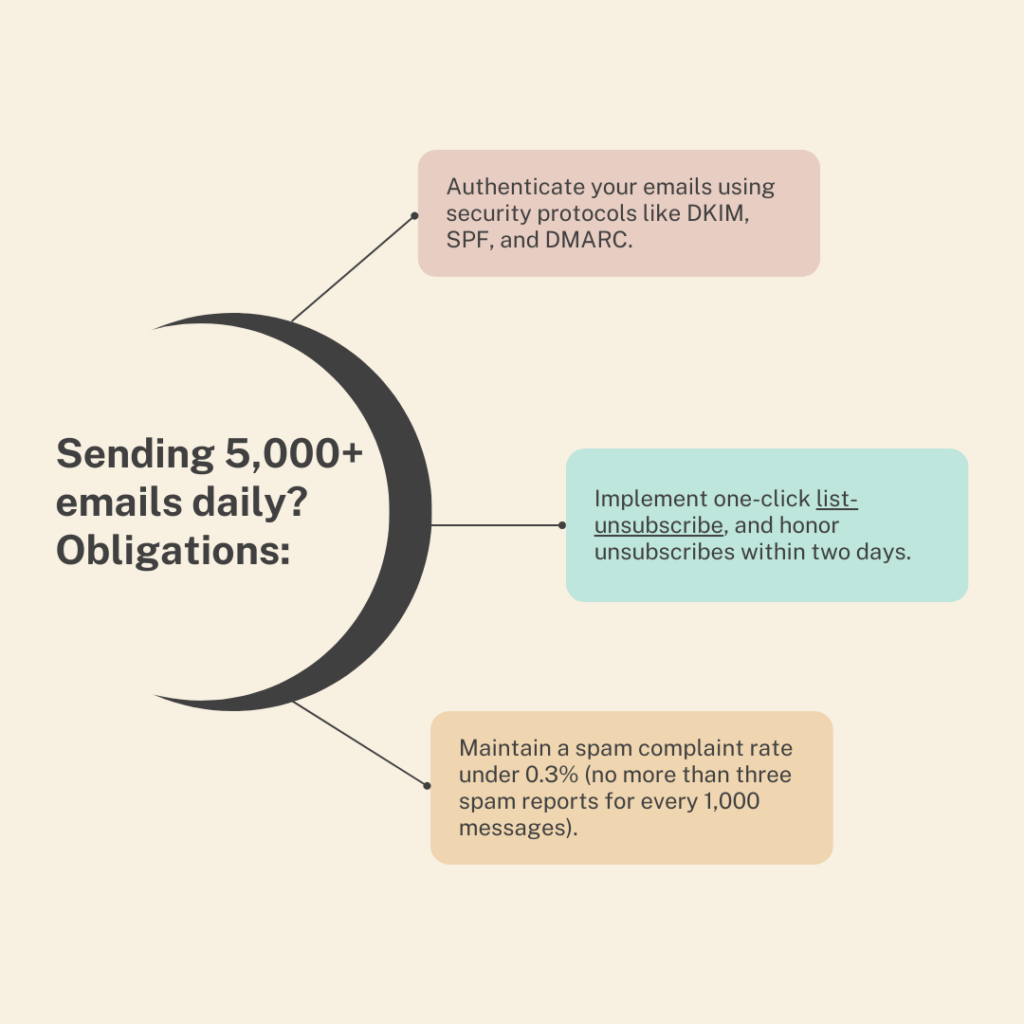Google and Yahoo are changing the email game – and you better be ready
Google and Yahoo have decided to shake things up in the email world. Starting from February 2024, they will introduce new rules for email deliverability that will affect anyone who sends more than 5,000 emails per day to Gmail and Yahoo accounts. And trust me, you don’t want to mess with these rules.
Why are they doing this? Well, they say it’s to improve the security and trustworthiness of emails, and to protect their users from phishing, spam, and malware. But I think it’s also to flex their muscles and show who’s boss in the email market. After all, Gmail and Yahoo have a combined share of over 50% of the global email users. That’s a lot of power.
What are the new email deliverability rules?
So, what are these new rules? And how will they affect your email marketing? Let me break it down.
The key areas of focus for these rules are authentication, unsubscribing, and spam threshold. The new email sender guidelines are a set of requirements and best practices that Google, Yahoo, and AOL expects email senders to follow when sending emails to their users. On the surface, the guidelines might look like best practices to follow for better email deliverability. But the new guidelines have a few nuances to pay attention to.
- Stricter Email Authentication: The email authentication protocols (SPF, DKIM, and DMARC) have transitioned from recommendations to requirements for senders who dispatch over 5,000 emails daily. These are protocols that help verify your identity as a sender and prevent others from impersonating you. If you don’t have them set up, Google and Yahoo will not trust you and will treat your emails with suspicion.
- Fully Qualified Reverse DNS Setups: This is a bit technical, but basically it means that you have to link your sending domains to your IP addresses. This helps Google and Yahoo to check that you are who you say you are, and that you are not using some shady or shared IP address. If you don’t have this set up, Google and Yahoo will think you are hiding something and will flag your emails as spam.
- One-click unsubscribe: This is a no-brainer, but apparently some of you still don’t get it. You have to provide a clear and easy way for your recipients to opt out of your emails with one click. No more hiding the unsubscribe link in tiny fonts or making them jump through hoops to get off your list. And you have to honor their requests within 48 hours. If you don’t, Google and Yahoo will…you get it.
- Maintenance of Low Spam Complaint Rate: This is the most important one. You have to keep your spam complaint rate below 0.3%. That means no more than 3 spam reports per 1,000 emails. If you go above this threshold, Google and Yahoo will limit or stop your email delivery. And that’s bad news for your email marketing.

These rules apply to bulk senders and do not affect personal Gmail or Yahoo accounts. If you are just sending personal emails to your friends and family, you don’t have to worry about them. But if you are a marketer, a publisher, a retailer, or anyone who relies on email to communicate with your audience, you better pay attention. Google and Yahoo have partnered in this effort to reduce the risk of phishing, spam, and malware.
If your emails are not compliant, Google may take actions such as:
- Delay the delivery of your emails.
- Reject or bounce your emails.
- Mark your emails as spam or phishing.
- Display a warning message or a question mark icon next to your sender’s name.
- Reduce your sender reputation and deliverability.
The good news?
This isn’t an overnight switch. Google and Yahoo plan a phased, collaborative approach:
- February – Temporary deferrals of non-compliant email.
Starting February, if you are non-compliant, then you’ll start to notice delays in emails or even error messages (4xx responses) to your emails. But they will still reach their destination after a few tries. You should check your email activity and see why some emails are delayed. The error messages will give you some hints. But be careful, you might not notice the delay if you don’t look at your logs or pay attention to your email delivery.
- April – Rejection of some non-compliant messages.
In April, Google will start to reject a percentage of non-compliant emails, which means that they will not be delivered at all and will be returned to the sender. This includes the whole list of requirements that Google has outlined in their Email Sender Guidelines, except for the one-click unsubscribe link. you should make sure that your emails are fully compliant by this date, or you will risk losing your Gmail subscribers and damaging your sender reputation.
- June – Deadline for one-click unsubscribe.
Google will enforce the one-click unsubscribe link requirement, which means that you will need to provide a simple and easy way for Gmail users to opt out of your emails with one click. One-click Unsubscribe should be part of your email policies – let’s not trouble our readers. If they want to opt-out let’s, make it easy for them. This would not only improve the user experience but also reduce the likelihood of your emails being marked as spam.

How will the new email sender guidelines impact the B2B industry?
The new email sender guidelines will have a significant impact on the B2B industry, as email is one of the most widely used and effective marketing channels for B2B brands.
81% of B2B marketers used email newsletters in the last 12 months, and 87% rated them as the most effective type of content for nurturing leads.
CMI’s 2023 B2B Content Marketing Benchmarks, Budgets, and Trends report
B2B marketers have a lot to lose out on if they don’t comply with the new guidelines. The new guidelines will also present some opportunities and challenges for B2B marketers, such as:
- Improving the quality and relevance of their email campaigns and providing more value and benefits to their subscribers.
- Increasing the security and privacy of their email communications and protecting their subscribers’ data and information. Your organization would be GDPR compliant and reduce the risk of cyberattacks and data breaches.
- Facing more competition and noise in the inbox and having to stand out from other email senders who are also following the new guidelines. This will require more creativity and innovation, and testing and optimizing their email campaigns to improve their performance and results.
So, there you have it. The new email deliverability rules from Google and Yahoo. They are not here to make your life harder. They are here to make email better. Better for you, better for your recipients, and better for the email ecosystem. If you follow these rules, you will not only avoid the wrath of Google and Yahoo, but you will also improve your email performance, engagement, and ROI. And that’s what we all want, right?
What are some best practices to follow for the new email sender guidelines?
- Update SPF and DKIM settings: Ensure that your email authentication protocols, such as SPF and DKIM, are properly configured to verify your sender identity. This will help improve security and deliverability.
- Implement a DMARC policy: Set up a DMARC policy that aligns with your SPF and DKIM settings. DMARC (Domain-based Message Authentication, Reporting, and Conformance) helps protect against email spoofing and provides visibility into email authentication failures.
- Set up fully qualified reverse DNS: Link your sending domains to their respective IP addresses through fully qualified reverse DNS setups. This helps in establishing a connection between your domain and IP address, enhancing authentication and reputation.
- Include clear unsubscribe options: It is now mandatory to include straightforward and easily accessible unsubscribe options in your commercial emails. Make sure your subscribers have an easy way to opt out of receiving further email communications.
- Monitor spam complaint rate: Regularly monitor your email campaigns to keep the spam complaint rate below the recommended threshold of 0.1%. This ensures consistent deliverability and helps you stay away from the high-risk threshold of 0.3%.

